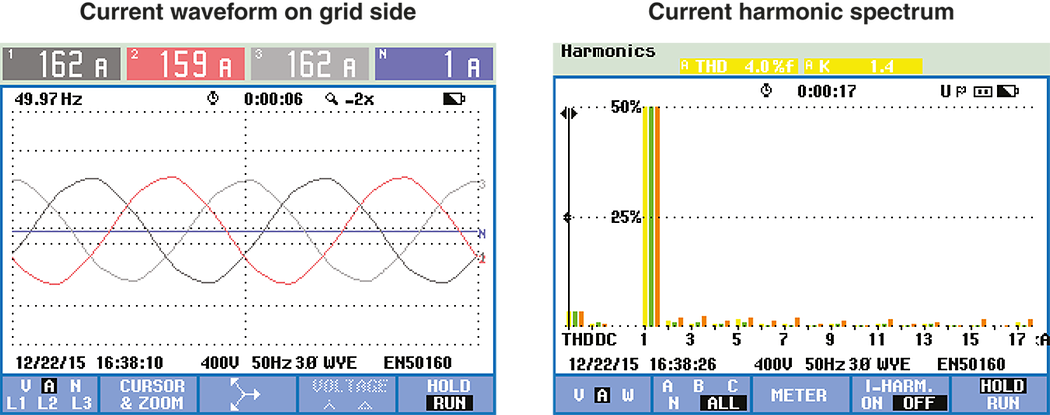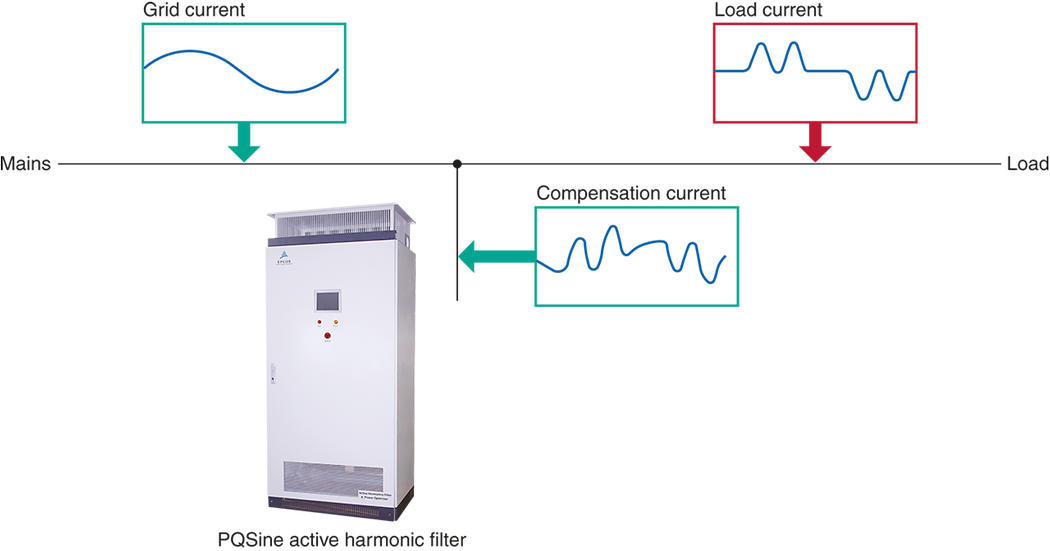Eliminating Power Quality Issues in Skyscrapers with Harmonic Filters
Eliminating Power Quality Issues in Skyscrapers with Harmonic Filters
By:Eduardo Drehmer
Imagine you need to update wiring in the 2.5-million-square-foot Empire State Building. You would need to pay at least $200 a drop for wiring (likely more when you add in the labor of a skilled electrician). The project would cost more than 100 times the cost per square feet that it takes to update wiring in the average home!
Power networks in large modern buildings, like skyscrapers, are complex and must address a wide range of nonlinear loads; active power conditioning is required to eliminate power quality issues. Power conditioning typically involves a device that improves the quality of the power delivered to electrical load equipment in order to maintain proper voltage levels and function properly. The latest active power conditioning solutions are based on active harmonic filters.
Powerful Challenges
Skyscrapers and other large buildings tend to utilize many power electronics systems that support nonlinear loads such as those required by UPS systems, servers and related computing equipment, variable speed drives, lighting, PoE networks, and monitors. Add in numerous other cables and potential pollutants that share nearby space, and you end up with harmonics pollution in the power network. This leads to significant supply voltage deterioration and quality, a major concern for building operators.
Dangerous Pollution
There are several dangers that are caused by harmonic pollution. The nonlinear current draw results in harmonics that cause distortion in the sinusoidal voltage. This distortion often causes interference for other loads.
Harmonics are integer multiples of the basic frequency (ie. the line frequency of 50 Hz or 60 Hz). Harmonics have fluctuating amplitudes that may extend into the upper kHz range. Aside from its negative effect on power quality, harmonic pollution can also be dangerous. Common negative effects include:
- Poor power grid quality
- Malfunctions of power loads
- High inadmissible currents
- Inadvertent current load on the neutral conductor
- Accumulative harmonic currents (of the 3rd, 9th, 15th, 21st orders, and so forth)
- Phase asymmetry (especially with single-phase switch-mode power supplies)
- New generations of harmonics
In some cases, harmonics can damage sensitive computing or medical devices to the point where they become unusable. This is a concern especially for data networks, servers and computers, where a malfunction of any of these devices can lead to corrupted data, causing untold financial damages to both devices and data.
Tower Power Quality
Given the sheer size and complexity of the electrical loads and systems of large buildings, quality is crucial in ensuring lowest possible energy consumption, avoiding overheating, minimizing equipment damage and malfunction, and reducing costs, production, and process downtimes.
Within such large buildings, the most significant electrical loads include:
- Air Conditioning: The inverters employed in air conditioning need reactive power compensation as they are a significant source of harmonic distortion. They typically produce dominant harmonic distortion in the 5th, 7th, 11th and 13th order, but also in the 17th and 19th order and above.
- Computing and access control: Computing and access control include computing networks and IT equipment, UPS, security systems, and access control systems. This is because the switched mode power supplies found in such equipment generate harmonic distortion in the 3rd to 23rd order and above. They also must have a reliable power supply that is protected from interruptions.
- Elevators: Some of these large buildings have more than 100 elevators, requiring reactive power compensation to be dynamic, changing quickly between inductive and capacitive when they feed recuperative power back into the network and also during operation. The total harmonic distortion, as a result, changes rapidly and is very high. They produce harmonic distortion in the 5th, 7th, 11th and 13th orders.
- Lighting: in such buildings, indoor and outdoor lights will typically be LED and CFL to save energy. However, lighting generates significant harmonic distortion in the range from 150 Hz up to 2500 Hz. Many of these buildings have large outdoor or indoor digital billboards that also contribute to distortion. Typically lighting causes harmonic distortion in the 3rd order, but harmonic distortion may also be present up to the 50th order depending on the type and number of devices.
- Safety: Devices including fans, water pumps, cooling machines, and fire protection are an important part of the overall building safety. These devices utilize 6-pulse power converters that contribute to harmonic distortion in the 5th and 7th order and above.
Power Conditioning
As you might imagine, Skyscrapers have a very complex load profile that reduces harmonic distortion across an extremely broad frequency spectrum that also involves dynamic reactive power compensation. As a result, complete power conditioning solutions, such as TDK's PQSine S series, that incorporate active harmonic filtering is optimal to address these complex loads.
A detailed analysis of the building's power network must be performed to design such a complex power conditioning solution. Distributors and manufacturers that specialize in power quality will work together with application engineers during the construction phase to analyze the load on the overall building. In nearly all cases, the analysis will identify significantly elevated THD levels and transient harmonics in all feeders of a building's network. In a typical office tower distortion is especially high in the 3rd, 5th, 7th, 11th and 13th harmonics.
Engineers can then take this analysis and power quality requirements, and incorporate other mandated power-related issues including energy savings, reliability and government regulations into their design to create an ideal solution. Such a solution should combine active and passive harmonic filters, de-tuned capacitor banks, and low and medium voltage automatic power factor correction systems.
High performance and reliability
Most power conditioning solutions are designed for 3-phase grids and require both high performance and reliability. Such solutions can be used with or without neutral conductors and enable harmonics to be detected and filtered in the 2500 Hz/3000 Hz range (50th order)
It is essential to ensure balancing of the loads to all three phases as is the case for TDK's PQSine active harmonic filters. Using a 4-wire device, neural conductor currents can also be compensated with minimal line resonance. This ensures the high performance and reliability that is required.
When designing an optimized active harmonic filtering solution engineers should create or select a solution with the following key features:
- Dual-function harmonic and reactive power compensation: Such active filter solutions should effectively compensate system harmonics, while at the same time providing fast reactive power compensation for both capacitive and inductive loads, keeping the system power factor at very nearly 1.0.
- Intelligent switching: Utilizing a special bus system allows engineers to ensure that any two of the three ACB cabinets (two incoming and one bus coupler) are always switched in for performance and redundancy purposes.
- Near-real-time reaction speed: Active filters should have a reaction time of under 50 µs to respond to rapidly changing loads quickly.
- Modular expansion: When power conditioning systems are designed, engineers should also consider future system expansion and changing requirements. Consequently, power conditioning cabinets should contain at least two empty slots to allow for future needs.
- Self-monitoring: Another way that engineers can plan for future requirements is to ensure that self-monitoring systems are designed into the active harmonic filters. The most important of systems to include are overload protection, shutdown on overtemperature, protection against overvoltage or undervoltage and fan monitoring.
Active harmonic filters such as the PQSine S series, should be installed in parallel to the polluting loads so they can analyze the line current and associated harmonics. In turn, they can then generate a compensation current to neutralize the harmonic currents and feeds a compensation current into the grid in real-time, effectively canceling any nonlinearity of the load current.
Active harmonic filters in power conditioning solutions not only mitigate harmonics but are very effective in providing the dynamic and reactive power compensation required in large commercial buildings. By following these best practices, engineers can address a wide range of nonlinear loads and eliminate power quality issues in skyscrapers and other large commercial buildings.

Figure: Typical performance analysis of a power supply system showing the presence of significant harmonic distortion in all harmonics, especially in the 3rd, 5th, 7th, 11th and 13th orders.

Figure: With an active harmonic filter, the current phases become sinusoidal with a very low level of THD-I and the power factor was nearly 1.0.
![]()
Eduardo Drehmer is Director of Marketing at TDK Electronics; Film Capacitors and Power Quality Solutions.
TDK
Volume: 2020 November/December






